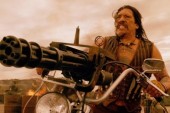
Early on in Safe House there’s a sequence in which Denzel Washington runs from a pack of gunmen. As luck would have it there’s a massive rally on the street: at least several hundred people are standing about, many waving placards, mounting what appears to be the most generic protest ever. We’re not prompted to read the slogans, but they’re along the lines of “JOBS!” and “TIME FOR CHANGE!” and other utterly vague, anodyne demands.
This may seem a small complaint, but it goes to the heart of what’s wrong with big-budget dreck like Safe House. In the not-too-distant past, even the most commercial Hollywood director would’ve taken the opportunity to insert a wee bit of specific, real-world context, if only for the sake of verisimilitude. But these days, Hollywood goes out of its way to ignore real-world concerns. It’s especially galling here, because the film is set in Cape Town, South Africa (it was shot there, too), a locale we almost never see in movies. And yet for all we learn of the city, it might as well have been shot in Toronto.
The movie itself is like that protest: sound and fury, signifying nothing. First-time screenwriter David Guggenheim has provided what I guess can be called a screenplay in that the actors speak words and aren’t improvising them. But there’s so little plot or character detail that it seems almost like an experimental film. The gist is that Washington is a rogue CIA operative, one who’s been on the lam for 10 years, and when the film begins he’s clandestinely purchasing some sort of top-secret document from an MI6 agent. Whatever’s in that document, other people want it, too, and the CIA track him down and bring him to a so-called “safe house” — an anonymous bunker hidden somewhere in the middle of Cape Town — for interrogating and, when he won’t cooperate, torturing. Ryan Reynolds plays the CIA newbie who runs the safe house — he’s like a bored innkeeper at an unfrequented motel — and, due to plot mechanisms too routine to recount, he ends up on the lam with Washington. Meanwhile, at CIA headquarters in Langley, Sam Shepard, Vera Farmiga, and Brendan Gleeson get paid millions to watch events unfold on huge monitors while talking gravely into their cell phones.
That’s about it, really. The safe house concept goes completely unexplored; the top-secret document is clearly a macguffin; and in between all the car chases and shoot outs we learn next to nothing about our two protagonists. There aren’t even jokes or tired catch-phrases. There is a minor attempt to provide narrative interest toward the end of the film — we learn, finally, why Washington’s character has been on the run all these years — but this “surprise” revelation is so naïve and half-hearted it almost seems like a put-on. All I could think during the movie was: who is this David Guggenheim guy? Did he used to have thoughts? Attitudes? A personality? How did he become the screenwriting equivalent of a black hole? It’s possible that a really stylish director could’ve found a way to turn all this nothing into something — Nicolas Winding Refn almost did it with Drive — but Swedish director Daniel Espinosa, who’s been touted in Hollywood as the next big thing, is not that director. From the evidence here, he’s barely a director at all.
Though the movie cost a reported $85-million, Espinosa makes it look as if it was shot with an iPhone. I can’t think of a recent studio production that’s as flat-out retina-searing as this one: washed-out, ultra grainy, full of sickly colours, nonsensical framing. And it’s all edited together with complete disregard for spacial continuity, pacing, and basic storytelling. (This isn’t Tony Scott bad, it’s sub-sub-Tony Scott.) Espinosa’s earlier claim to fame was a 2010 crime movie called Snabba Cash, which sounds like a ’60s-era Hanna-Barbera character but is actually just Swedish for Easy Money. I didn’t see the movie (it didn’t get a theatrical release here), but I was immediately suspicious of it when I heard the Hollywood powers-that-be were fans. They’re not on the lookout for artists or even great stylists when they deign to watch foreign films; they’re looking for cheap talent they can count on to churn out the same old routine stuff, talent who’ll be grateful just for the opportunity. I suppose it’s unfair of me to cast aspersions on Snabba Cash without having seen it, but after a movie like Safe House, I can live with the guilt.
____
Scott Macdonald is Toronto Standard’s film critic. You can’t follow him on Twitter but you can close your eyes and wish him a happy Friday.
For more, follow us on Twitter at @torontostandard, and subscribe to our newsletter.














